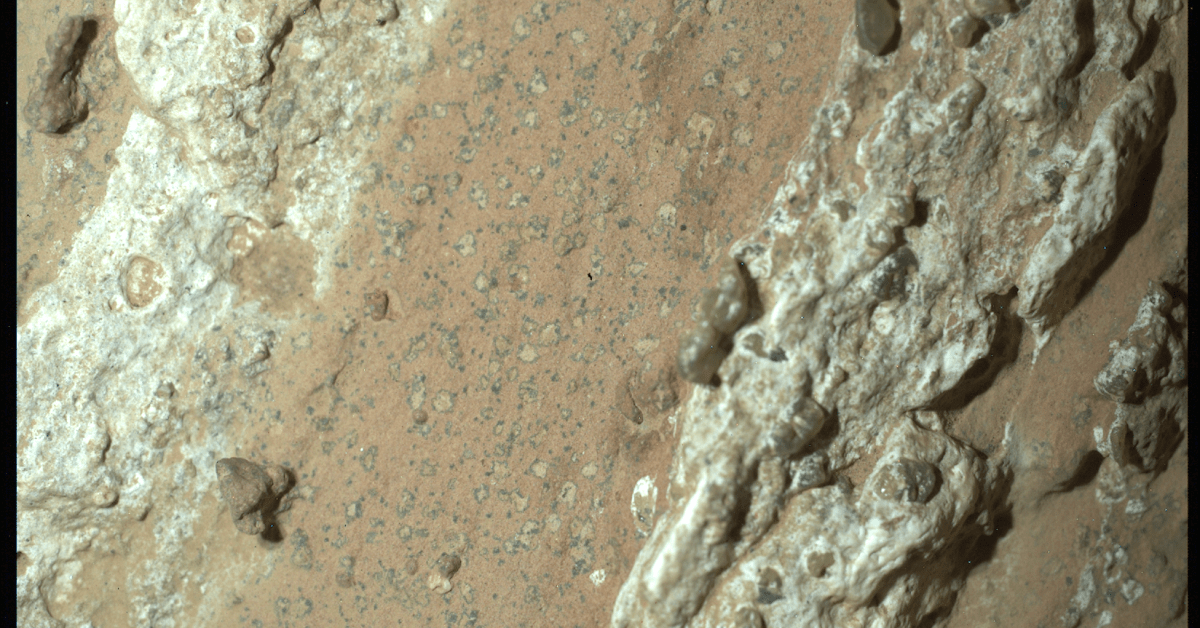When the Perseverance rover landed in Mars’s Jezero crater—a formation that long ago was Jezero lake—in February, 2021 it turned west. West is where the riverbeds, the deltas, the sites of ancient gushing water once were. In July, 2024, after covering 18 miles in nearly three and a half years, it arrived at a quarter-mile-wide river valley that is home to a 3.2-ft.-long rock NASA scientists have dubbed Cheyava Falls—and there it hit paydirt. As a new paper in Nature reports, a sample Perseverance drilled from the rock may contain potential biosignatures of long ago microbial life.
“This finding by Perseverance…is the closest we have ever come to discovering life on Mars,” said acting NASA administrator Sean Duffy in a statement. “The identification of a potential biosignature on the Red Planet is a groundbreaking discovery, and one that will advance our understanding of Mars.”
Perseverance did not discover fossilized microbes and it surely didn’t discover living ones. What it found was a rock streaked in a range of colors—red, green, purple, and blue—flecked with poppy-seed-like dots and decorated with what the Perseverance scientists compared to dull yellow leopard spots. That said a lot. As the rover’s instruments confirmed, the red is iron-rich mud, the purple is iron and phosphorous, the yellow and green are iron and sulfur. All of those elements serve as something of a chow line for hungry microbes.
The poppy seeds and leopard spots, meantime, resemble markings left behind by metabolizing microbes on Earth. When the rover trained its instruments on those features they detected two iron-rich minerals—vivianite and greigite. On Earth, vivianite is frequently found in peat bogs and around decaying organic matter—another item on the microbes’ menu. And both minerals can be produced by microbial life. Images of the rock with its distinctive features were beamed back to Earth by Perseverance, while X-ray and laser sensors analyzed the chemistry of the markings.
Read more: Ancient Microbes Could Still Be Living on Mars
“What’s exciting about these finds,” said Joel Hurowitz, lead author of the Nature paper and a member of the Perseverance science team, at a Sept. 10 press conference, “[is that] this sort of combination of mud and organic matter…is what we see in sediment on Earth. These minerals are often the byproduct of microbial metabolisms that are consuming organic matter and making these minerals as a result of those reactions.”
“Astrobiological claims, particularly those related to the potential discovery of past extraterrestrial life, require extraordinary evidence,” said Katie Stack Morgan, Perseverance’s project scientist, in a statement. “Getting such a significant finding as a potential biosignature on Mars into a peer-reviewed publication is a crucial step in the scientific process because it ensures the rigor, validity, and significance of our results.”
But those results are by no means a closed book. The wording used to describe the find—”potential biosignature”—is a very precise term of art. A potential biosignature, as NASA wrote in its release, is “a substance or structure that might have a biological origin but requires more data or further study before a conclusion can be reached about the absence or presence of life.” In other words, hold the Nobel.
“There are non-biological ways to make these features that we cannot completely rule out,” said Hurowitz at the press conference. “So what we need to do from here is to continue to do additional research in laboratory settings here on Earth, and ultimately bring the sample that we collected from this rock back home to Earth, so that we can make the final determination for what process actually gave rise to these fantastic textures.”
Bringing samples of the rock home is very much on NASA’s exploratory agenda. Perseverance was launched with 43 small titanium tubes that it has been filling with soil and rock and leaving on the surface like a bread crumb trail. The sample Hurowitz mentioned was one such cached bit of Mars. For decades, NASA has been talking about a Mars Sample Return (MSR) mission, and Perseverance was intended to be the first step in that game of fetch. But the next steps have never been fully planned. NASA has envisioned landing another small rover on Mars that would chase after Perseverance, collect the samples the larger rover has left on the surface, and bring them to a return ship that would blast off of Mars and carry them up to an Earth-Return Orbiter (ERO)—built by the European Space Agency —which would be waiting for the precious cargo. The ERO would then carry the sample tubes home.
Despite the fact that Perseverance has been diligently filling its tubes and leaving them on the surface, none of the other hardware for the complicated MSR relay has been built. And the new administration may be further hampering those plans. In Early May, President Donald Trump issued a budget request that would slash NASA’s funding by 24%, with multiple programs being scaled back or canceled. MSR is one of the ones that got the ax. Congress, of course, still has to approve of Trump’s request, and at Wednesday’s press conference Duffy was asked about MSR’s future.
Read more: NASA’s Mars Rover Mission to Bring Samples Back Home From the Red Planet Is at Risk
“What we’re going to do is look at our budgets,” he said. “We’re going to look at our timing. And, you know, how do we spend money better? And what technology do we have to get samples back more quickly? And so that’s a current analysis that’s happening right now. Again, what is the best way to do it?”
That’s not a ringing endorsement for MSR, but it’s not a no either. As Washington debates the future of the space agency, the Perseverance team can only go about its business, sending its rover this way and that, to sniff out clues to Mars’s ancient past. The planet may once have been living—far below the surface, in underground aquifers, it could still be living. The latest findings are one more sign that we may not have always been alone in the solar system.








